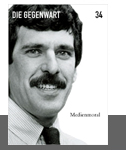
Institute for Public Accuracy
Das von Norman Solomon
gegründete Institute for Public Accuracy ist eine Plattform für unabhängige
Medienforscher und Journalisten in Amerika. Eine Prämisse des Instituts ist
es, über den Tellerrand der Massenmedien hinweg zu blicken, um dem Leser
Aussichten zu gewähren, die in den Massenmedien oftmals zu kurz kommen.
Dabei betrachtet das IPA Perspektiven fernab von jeglichen think tanks
oder anderen einflussreichen In-stitutionen. Die Publikationen basieren auf
qualitativ recherchierten Analysen. Als Netzwerk betrachtet liefert das
Institut ein breites Spektrum an verschiedenen Meinungen und Kenntnissen und
macht einen Meinungs- und Informations-austausch von hunderten von
unabhängigen Forschern und Journalisten in den Vereinigten Staaten möglich.
Dieser ganze Prozess sorgt für eine trans-parentere Mediendiskussion als sie
in den Massenmedien geführt wird.
 Institute
for Public Accuracy Institute
for Public Accuracy |
Today that
question echoes more ominously than ever. While advertising and other
commercial messages keep extending their reach, news coverage routinely
gives fuel to society's preoccupation with financial assets. Fixated on
money and what it might bring, the media fascination with purchasing power
never stops. Mainstream news organizations have steadily shifted resources
and priorities to the business of business. When PBS launched "Wall Street
Week" with Louis
Rukeyser in 1970, the program was conspicuous. By the time Rukeyser departed
earlier this year, it was just one of dozens of national TV shows -- most of
them daily -- devoted to the quest for high returns. After "Moneyline"
premiered on CNN in 1980, cable television news grew while embracing the
world of investment. In 1989, General Electric opted to dedicate much of its
startup news channel CNBC to coverage of and commentary about the stock
market.
A decade later, when host Lou Dobbs left "Moneyline" in spring 1999 at the
start of his two-year absence from CNN, it was the leading cable network's
most profitable show. By then, broadcast networks were fervently targeting
the same lucrative demographics, and not only with expressly financial
programs. Between the mid-1980's and the late 1990's, the main TV networks
doubled the amount of airtime devoted to the New York Stock Exchange and
Nasdaq.
|
|
Regular news shows got accustomed to lavishing attention on minor
business developments not because of significant economic implications for
the general public, but because of decisions being made by management
executives with oversight of news departments. Some viewers,
the ones with plenty of disposable income, became far more
equal than others.
When CNN revamped its daytime schedule in mid-1999 to make room for three
and a half hours of programs about commerce and investment, the cable
giant's president Richard Kaplan explained: "We look at business and finance
as something we have to cover on a general interest news network. It's like
the Cold War in the '50's. You just have to do it." And the unstated goal
was not simply to attract a higher number of viewers. As The Associated
Press reported last year, noting intense competition between "Moneyline" and
CNBC's "Business Center" program: "The audiences are small, but affluent, so
advertisers pay a premium to run commercials."
Many news
stories now amount to little more than human interest narratives about the
glories and tribulations of entrepreneurs, financiers and CEO's. At networks
owned by multibillion-dollar conglomerates like General Electric, Viacom and
Disney, the news divisions solemnly report every uptick or downturn of the
markets. In contrast, when was the last time you heard Tom Brokaw, Dan
Rather, or Peter Jennings report the latest rates of on-the-job injuries or
the average wait times at hospital emergency rooms? While many viewers
assume that coverage reflects the considered judgment of journalistic pros,
those journalists are enmeshed in a media industry dominated by corporate
institutions with enough financial sway to redefine the meaning of
functional professionalism.
In theory,
noncommercial TV and radio outlets are insulated from the inordinate power
of money. But across the country, each year, "public broadcasting" relies on
hundreds of millions of dollars from corporations that are pleased to
provide underwriting to burnish their images among upscale viewers and
listeners. Whatever other benefits accrue, those firms buy some valuable PR
with their de facto commercials, known euphemistically in the trade as "enhanced
underwriter credits."
Along with
the politically appointed board of the nonprofit Corporation for Public
Broadcasting, corporate donors exert hefty influence on programs by "underwriting"
-- and, in some cases, literally making possible -- specific shows. Private
money is a big determinant of what's on "public" broadcasting. Without
corporate funding for specific programs, many current shows would not exist.
Public television airs the "Nightly Business Report," but viewers can search
in vain for a regular show devoted to assessing the fortunes of working
people. At PBS, no less than at avowedly commercial networks, the operative
assumption seems to be that wealth creates all labor, not the other way
around. Back in the 1770's, Adam Smith articulated a more progressive
outlook, writing: "It was not by gold or by silver, but by labor, that all
the wealth of the world was originally purchased."
Years ago,
National Public Radio initiated "NPR business updates" to supplement
newscasts many times each day on stations nationwide. Listeners will be
disappointed if they wait for an "NPR labor update." Various public radio
stations feature "Marketplace," a national daily program, and the weekly
"Sound Money" show, but there is no broadcast such as "Workplace" or "Sound
Labor."
Meanwhile,
print outlets are loaded with money-related obsessions. Time and Newsweek
have often done cover stories on the race to amass wealth which were upbeat
or even ecstatic in bullish times, and somber when the news is hard for
investors to bear. In the quarter century since The New York Times founded
its "Business Day" section, daily papers have turned more and more newsprint
over to targeting the affluent readers most coveted by business advertisers.
The Washington Post's daily business section went from two to 12 pages.
Around the country, the pattern has been similar, with dailies vastly
enlarging their financial coverage -- at the expense of other news. The "general
circulation" press has become transfixed with the investor.
Along the way, these trends have
transformed basic concepts of what it really means to be a journalist. "As
the 1980's rocketed along, our 'readers' became 'consumers,'" recalls New
York Times reporter Diana B. Henriques. "As the 1990's unfolded, those 'consumers'
morphed into 'investors.' And today, some of us are speaking only to
investors who also own computer modems." The quality of mainstream
journalism has always suffered due to the power of big money in the form of
ownership and advertising, but flawed bygone eras are apt to evoke fond
nostalgia in the present day. "As our intended audience has gotten narrower,
so have we," Henriques lamented in Columbia Journalism Review's last issue
of 2000. "Business news today rarely sounds the sonorous chords or
heart-lifting themes of great journalism. Most of it simply buzzes and
squeaks, a reedy clarinet against a rhythm section of cash registers and
ticker tape."
Back in 1989, business reporter David Cay Johnston, then at the Philadelphia
Inquirer, told me: "The financial pages of the newspapers of this country
see the world through the eyes of bankers as opposed to through the eyes of
bank customers."
These days,
his words also apply to many other pages of newspapers -- as well as to
other types of media outlets. With business stories migrating so extensively
across the media board, the accompanying sensibilities and priorities have
drastically shifted mindsets about "news." Idolatry of high-tech magnates,
from Bill Gates on down, harmonizes with a prevalent tone that presents
dollar assets as tacit measures of human value. In sharp contrast, across
the mass-media landscape, average workers hardly qualify as noble. Often,
their very human needs come across as clunky impediments to economic
progress.
Contemporary
journalists are accustomed to depicting the "cost" of the work force as a
barrier to wealth creation. In the midst of the last decade's great boom, on
April 30, 1997, a cheery article about the latest economic news appeared
under this headline on the front page of The New York Times: "Markets Surge
as Labor Costs Stay in Check." (For non-affluent readers, the headline might
as well have read, "Great News: Your Wages Aren't Going Up.") "The stock
market rocketed yesterday to its greatest gain in more than five years," the
Times reported. Why? Because important people were happy that wages had
barely increased in the United States, and employers had not shelled out
more for "benefits like health insurance and pensions." The story
spotlighted the jubilant comment of a senior economist at Goldman Sachs: "There
is no question this is a better labor cost report than we had anticipated."
Indeed, the conditions were "better" for employers. How about employees?
Well, they didn't merit any ink. The 18-paragraph article quoted a few
current and former government economists without a word from workers, their
representatives or labor advocates.
Monologues of
mass media keep confronting viewers, listeners and readers with a demand
that is frequently implicit: "How much are you worth?" The usual response
provided to us: "Not enough."
At the same
time, big money tilts reporting and punditry. On major networks, we rarely
hear a strong voice speaking against the outsized power of large
corporations. Yet there are a few cracks in the media walls. In recent years,
Time magazine has featured several muckraking cover stories about corporate
influence and power that could hardly have pleased their targets. But the
essence of propaganda, as any ad exec knows, is repetition. When certain
stories and themes are repeated endlessly, the odds are stacked heavily
against occasional muckraking journalism reverberating inside the national
media's echo chamber.
Much of
journalism now routinely wields monetary yardsticks. Even the most esteemed
daily newspapers often cover cultural offerings by using dollar figures as
overarching benchmarks, highlighting the financial earnings of various films,
plays, books, paintings, CD's and music videos. The internalization of
dollars as markers for human worth and artistic achievement has insidiously
skewed how we view the meaning of culture and creativity. And the deep
concern that Packard voiced many years ago is rendered silent, in part by
the unwillingness of most American journalists to keep his question in mind.
Yet it is a question that, if asked, would surely alter the steady drumbeat
of today's reporting. "By encouraging people constantly to pursue the
emblems of success, and by causing them to equate possessions with status,
what are we doing to their emotions and their sense of values?"
 ZUM
SEITENANFANG ZUM
SEITENANFANG
|


